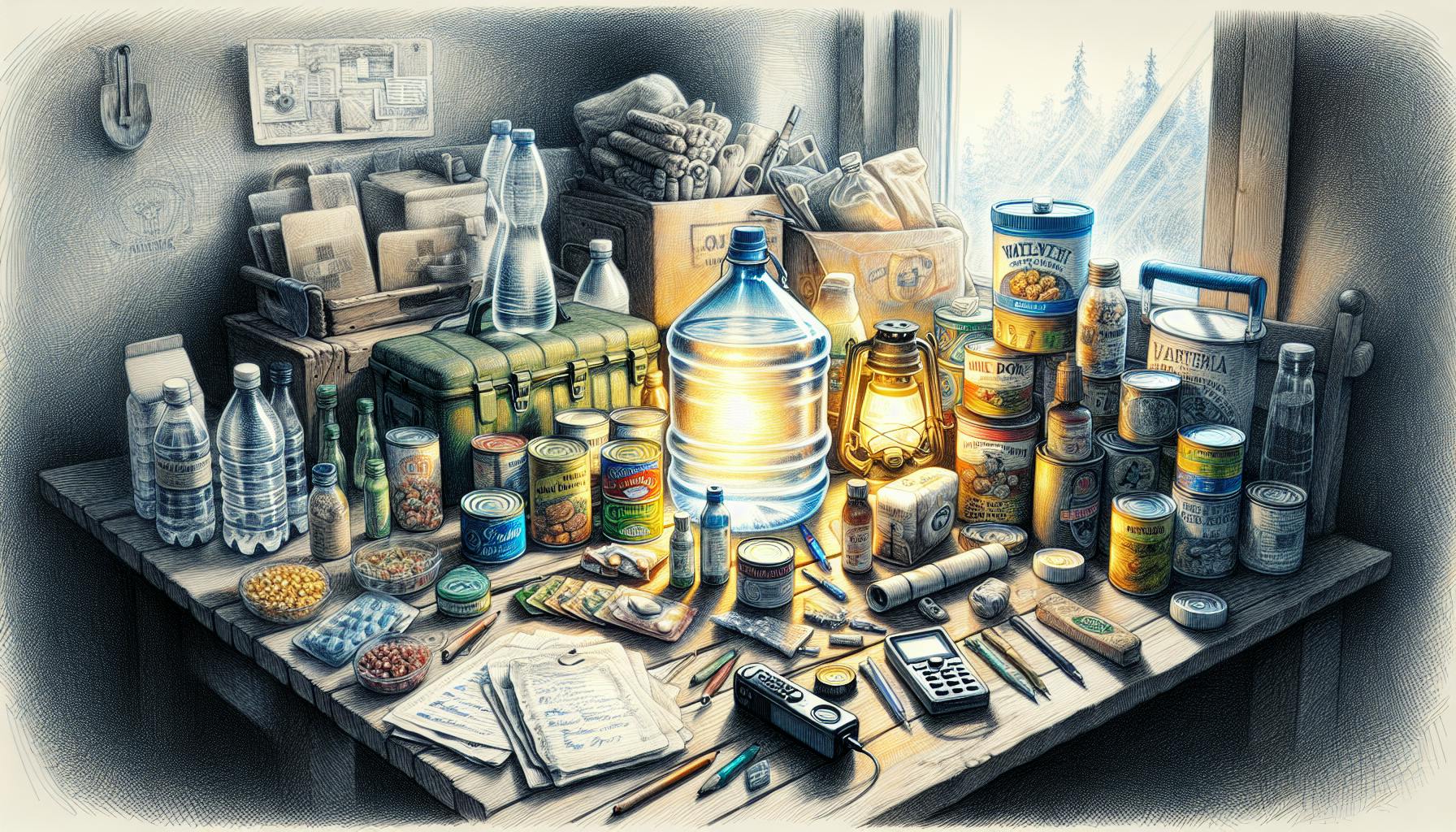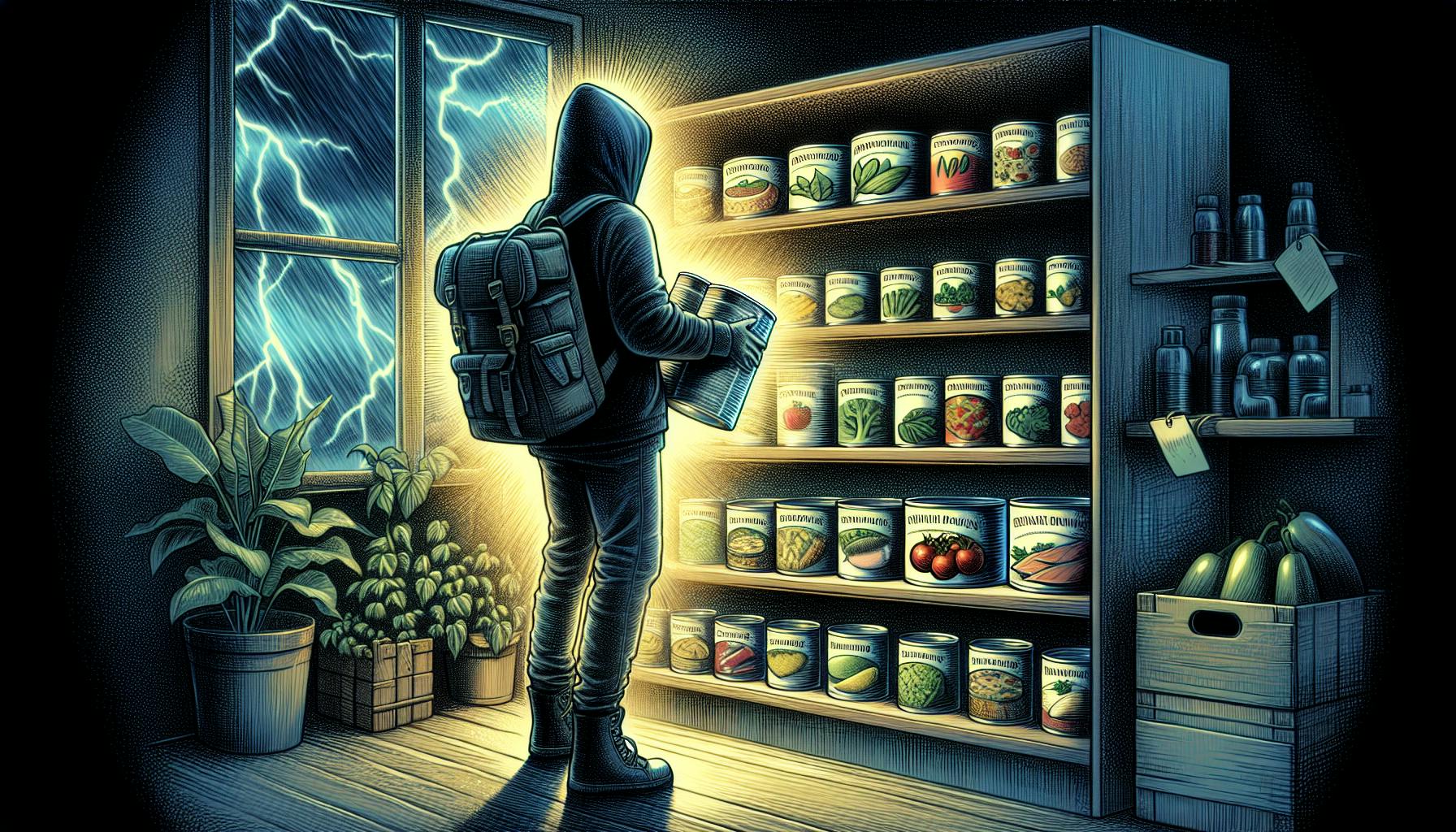Building a well-stocked prepper pantry is a crucial step in being prepared for any emergency situation, whether it be a natural disaster, economic collapse or other crisis. Having ample food and water reserves ensures your household will be able to safely subsist through any calamity. This article from WeLovePrepping provides essential guidance on stocking a robust emergency pantry when disaster strikes.
Why a Prepper Pantry is Vital for Emergency Readiness
When catastrophe hits, grocery stores are quickly wiped clean, sometimes in a matter of hours. Being prepared with adequate food and water supplies avoids panic and allows you to safely shelter in place during the chaos. A properly stocked prepper pantry has sufficient calories, nutrition and variety to comfortably sustain all members of your household for an extended duration.
The key is having shelf-stable foods with long expiration dates that can last 5-10 years or longer. While canned goods are convenient options, also consider lightweight, long-lasting freeze-dried and dehydrated foods that are easy to transport if needed. Follow the mantra “Store what you eat and eat what you store” by regularly incorporating your stockpile into meals. This ensures freshness and familiarity with the foods.
Be sure to rotate items using the “First In, First Out” system to maximize freshness. Take inventory of your reserves quarterly and replenish items that are expiring soon. WeLovePrepping's blog provides practical tips from experts and everyday preppers alike for building robust emergency pantries.
Stock Up On Nutrient-Dense Staple Foods
These versatile, calorie-dense staple foods should form the foundation of your prepper pantry. Prioritize stocking up on these essentials first when starting your reserves:
- Rice - White, brown, long-grain, etc. A long-lasting source of carbohydrates.
- Beans - Packed with plant-based protein. Stock up on varieties like pinto, black, kidney, lentils.
- Pasta - Storable and filling. Good choices are penne, spaghetti, macaroni.
- Canned goods - Canned meats, fruits, vegetables, soups provide convenience and portability.
- Oils - Olive oil, coconut oil, vegetable oil for cooking, fats and calories.
- Sugar, spices - For preserving and flavoring foods. Grow fresh herbs.
- Flour - For baking nutritious bread, pizza dough, tortillas, pancakes and more.
- Oats - Steel cut and rolled oats provide excellent breakfast calories.
- Grains - Quinoa, barley, etc for variety.
Rice, beans, oats, pasta and flour provide essential calories and carbohydrates, while oils offer concentrated fats and calories. Canned goods add portability, convenience and nutrition.
Supplement Your Reserves with Freeze-Dried and Dehydrated Foods
In addition to canned goods, stock up on these lightweight, long-lasting foods to add variety:
- Freeze-dried produce - Fruits, vegetables, meats retain 95% nutrition and 20+ year shelf life. Mountain House and Augason Farms offer high-quality options.
- Dehydrated apples, carrots, onions - Rehydrate with water as needed.
- Soup mixes - Add boiled water for a quick meal. Store 2-3 varieties.
- Butter powder, eggs - These dairy essentials store easily long-term.
- Trail mixes, granola - Healthy fat and calorie sources for snacking.
- MREs - Self-contained Meals Ready to Eat are convenient and portable.
- Premium brands - WeLovePrepping offers deals on Mountain House and Augason Farms foods.
Water Storage - The Most Essential Prep
Storing adequate water is vital for survival:
- Store at least 1 gallon per person per day minimum. 2 gallons is better.
- Bottled water is convenient short-term but takes up space.
- Collapsible pouches are flexible, portable and stack efficiently.
- 55-gallon barrels allow for robust, high-capacity water reserves. Use food-grade plastic barrels.
- Water filters, purification tablets allow you to purify found water sources.
- Replace and rotate water every 6 months at a minimum to ensure freshness.
Stock Up on Long-Lasting Protein Sources
Protein is crucial for health and survival. Stock up on:
- Canned meats - Tuna, chicken, salmon, beef and pork all provide protein.
- Nuts/seeds - Peanuts, almonds, sunflower seeds are calorie-dense.
- Dried meats - Jerky and pemmican are lightweight.
- Powdered eggs - Scramble up eggs after rehydrating with water.
- Canned meals - Chile, beef stew, ravioli offer variety.
- Protein bars - Store-bought and homemade bars are convenient.
- Freeze-dried meats - Carry lightweight, compact meat pouches.
Fruits, Vegetables and Vitamins
A balanced, nutritious diet includes:
- Canned produce - Load up on variety of canned fruits and veggies.
- Dehydrated veggies - Broccoli, spinach, kale store well when dehydrated.
- Freeze-dried fruits - Strawberries, blueberries, bananas retain flavor.
- Herbs/spices - Grow fresh herbs like oregano and parsley or store dried.
- Honey, molasses - These natural sweeteners last indefinitely.
- Citrus fruits - Stock up on vitamin C-rich oranges, grapefruits, lemons.
- Multivitamins - Prevent nutritional deficiencies.
- Individual supplements - Vitamin C, Vitamin D, calcium, magnesium tablets.
You can also sprout seeds like broccoli, radishes and microgreens to grow fresh greens.
Proper Storage and Organization of Your Prepper Pantry
Use these techniques to keep foods accessible and organized:
- Categorize foods by type - grains, canned goods, freeze-dried items, etc.
- Label everything clearly with contents and date. Use a marker or masking tape.
- Store in a cool, dark place if possible - like a basement pantry.
- Rotate stock using the First In, First Out (FIFO) method.
- WeLovePrepping offers helpful products like Gamma Seal lids and food-grade buckets.
Maximize Shelf Life with Proven Methods
Use these time-tested techniques to extend shelf life:
- Mylar bags and Oxygen absorbers - Block moisture and air from invading food.
- Food-grade plastic buckets - Seal out light, air and pests. Use Gamma lids for easy access.
- Canning - The heat sterilization process seals and preserves food.
- Freeze-drying - Removes nearly all moisture which prevents bacteria growth.
- Dehydrating - Creates low moisture environments where microbes cannot thrive.
- Vacuum packing - Removes oxygen so food cannot oxidize and spoil.
- FIFO rotation - Ensures you eat the oldest food first before it expires.
Creative Storage Solutions for Your Prepper Pantry
Make the most of your limited space:
- Shelving units and racks - Optimize vertical storage with floor-to-ceiling shelving.
- Underbed bins - Use all available vacant spaces efficiently.
- Converted closets - Repurpose what you already have in your home.
- Interlocking plastic bins - See contents easily. Stack and label.
- Standing pouches - Flexible containers conserve space by conforming.
- Strategic stacking - Play food tetris to efficiently use every inch.
- WeLovePrepping's Gamma Seal lids allow easy bucket access without tools.
Build Your Prepper Pantry Gradually Based on Needs
When starting out, build your reserves systematically over time:
- Take stock of current emergency supplies on hand.
- Calculate daily calories needed for each household member.
- Focus first on purchasing the most essential staple foods.
- Buy a little extra each grocery trip and when items go on sale.
- Prioritize familiar everyday foods you already eat and enjoy.
- WeLovePrepping can help assess the ideal food reserves and durations for your household.
Plan for Short-Term Disruptions of 1-4 Weeks
Be ready for temporary local emergencies:
- Have a minimum 3-day supply, but 2 weeks is recommended.
- Focus on staples that are easy to prepare like canned chili, soups, oatmeal.
- Include comfort foods like cookies, candy bars for morale.
- Calculate total calories required per person based on age, health and activity level.
- Have some board games, books and other entertainment options.
Brace for Long-Term and SHTF Scenarios
Hope for the best but prepare for extended disruptions:
- Work towards having a 1-3 month supply or more of staples.
- Rely on rice, beans, oats, wheat, pasta during prolonged crises.
- Consider sprouting seeds and microgreens.
- Learn skills like foraging, hunting and fishing to supplement food.
- If possible, establish renewable food sources like a garden.
- Focus on total calories above all else for survival.
Smart Shopping - Stock Up On Essentials
Shop carefully and avoid these common mistakes:
- Focus on long shelf life: 5-10 years is ideal.
- Take advantage of bulk pricing to maximize savings.
- Prioritize nutritious, calorie-dense staple foods.
- Include both canned goods and lightweight freeze-dried/dehydrated items.
- Choose familiar foods your family already enjoys and eats.
- WeLovePrepping offers the best deals on long-term emergency food.
Recommended Foods to Stockpile
Be sure to load up on:
- Rice, pasta, oats, flour, beans, lentils
- Canned fruits, vegetables, soups, meats
- Peanut butter, nuts, protein bars, trail mixes
- Cooking oils, honey, spices, salt, sugar
- MREs and freeze-dried meal pouches
- Dehydrated vegetables, fruits, milk powder
- Water and water purification supplies
Things to Avoid
Be wary of these categories:
- Perishable fresh foods with short shelf lives
- Refrigerated-only items
- Specialized dietary products
- Unnecessary junk foods like chips, sweets
- Anything your family doesn't eat regularly
Maintaining Your Prepper Pantry
Keep your pantry organized and up-to-date:
- Take a full inventory quarterly and check expiration dates.
- Establish a First In, First Out (FIFO) food rotation system.
- Repackage bulk items into smaller everyday use containers.
- Watch for sales to replenish and add variety.
- Incorporate stored foods into regular daily meal prep.
- Promptly replace anything expired, damaged or depleted.
Creative Ways to Use Your Stockpile
Seamlessly integrate emergency foods into daily life:
- Make rice pilaf, pasta salad, bean chili, oatmeal using stockpile.
- Add canned chicken, tuna, veggies to soups and casseroles.
- Bake bread, pancakes, tortillas using stored flour, baking mix, eggs.
- Enjoy stored trail mix, jerky, dried fruit and nut bars as snacks.
- Portion bulk items like rice and beans into everyday containers for easy use.
- Cook with your stocked oils, spices, honey and condiments.
Strategically Replenish Your Prepper Pantry
Restock efficiently:
- Review inventory and make a shopping list of needed items.
- Watch for sales, coupons and bulk discounts on key staples.
- Build reserves gradually over time within your budget.
- First replace expired/nearly expired foods to maintain freshness.
- Then add variety and nutrients with new items.
- Ensure total calories and nutrition needs are covered.
Key Takeaways for Creating Your Prepper Pantry
WeLovePrepping is your source for all the tips, checklists and gear to build a robust emergency food supply. To recap:
- Focus on long-lasting, versatile staple foods as the foundation.
- Include both canned and freeze-dried/dehydrated items for flexibility.
- Store at least 1 gallon of water per person per day, 2 gallons is optimal.
- Practice First In, First Out food rotation for freshness.
- Organize intelligently by type for quick identification and access.
- Build reserves methodically over time, starting with essentials first.
- Regularly incorporate storage foods into daily meal prep.
With proper ongoing management, your prepper pantry will be equipped to nourish your family through any catastrophic event. WeLovePrepping can guide you through the process of emergency preparedness every step of the way.


